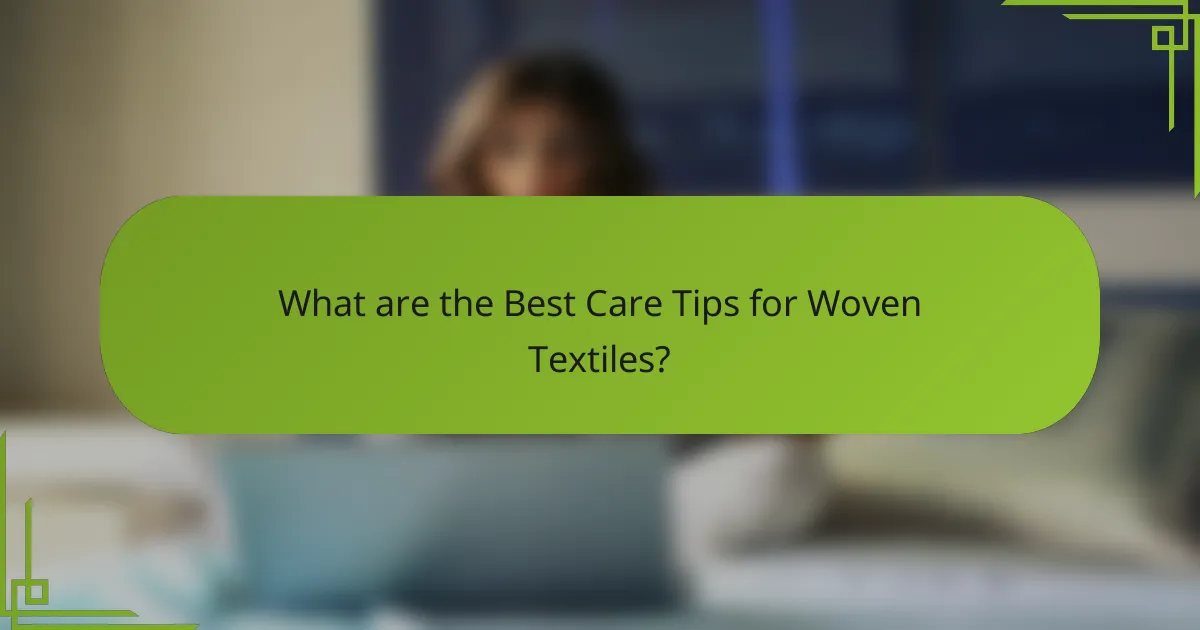
What are Woven Textiles and Their Significance?
Woven textiles are fabrics created by interlacing threads on a loom. This process forms a stable structure that enhances durability and aesthetic appeal. Woven textiles include various materials such as cotton, wool, and silk. They are significant due to their versatility in applications, including clothing, upholstery, and home décor. Historically, woven textiles have played a crucial role in cultural identity and craftsmanship. For example, traditional weaving techniques are essential in many cultures, preserving heritage and artistry. Additionally, woven textiles often provide comfort and warmth, making them popular choices for cozy spaces. Their significance also extends to sustainability, as many woven fabrics can be produced from natural fibers.
How are Woven Textiles Created?
Woven textiles are created through the interlacing of threads. The process begins with selecting fibers, such as cotton, wool, or synthetic materials. These fibers are spun into yarn, which serves as the foundation for weaving. A loom is then used to weave the yarn into fabric. The loom holds the warp threads in place while the weft threads are woven through them. This interlacing creates various patterns and textures. Different weaving techniques, like plain weave or twill, can produce distinct results. The final step involves finishing processes, such as washing or dyeing, to enhance the fabric’s appearance and feel.
What Techniques are Used in Weaving?
Weaving techniques include plain weave, twill weave, and satin weave. Plain weave is the most basic technique, involving an over-and-under pattern. This method creates a strong and durable fabric. Twill weave features a diagonal pattern, providing texture and drape. It is commonly used for denim and upholstery. Satin weave produces a smooth and glossy surface, often used for formal garments. Other techniques include jacquard weaving, which allows for intricate patterns, and tapestry weaving, which creates artistic designs. Each technique serves different purposes and results in unique textile characteristics.
What Materials are Commonly Used in Woven Textiles?
Common materials used in woven textiles include cotton, linen, wool, and synthetic fibers. Cotton is widely favored for its softness and breathability. Linen, made from flax fibers, is known for its durability and natural luster. Wool provides warmth and resilience, making it ideal for blankets and carpets. Synthetic fibers, such as polyester and nylon, are often used for their strength and resistance to wrinkles. Each of these materials contributes unique properties to woven textiles, enhancing their functionality and aesthetic appeal.
What Styles of Woven Textiles Exist?
Various styles of woven textiles exist, each with unique characteristics. Common styles include Jacquard, which features intricate patterns woven into the fabric. Tapestry is another style, known for its detailed imagery and artistic designs. Plain weave is a basic style, where threads cross over and under uniformly. Twill weave creates diagonal patterns and is often used for denim. Satin weave produces a smooth surface with a glossy finish. Each style serves different purposes in home decor and fashion. Woven textiles have been utilized for centuries, showcasing cultural significance and craftsmanship.
What are the Different Types of Woven Textile Patterns?
The different types of woven textile patterns include plain weave, twill weave, and satin weave. Plain weave is the simplest form, where the warp and weft threads cross each other in a straightforward over-and-under pattern. This creates a flat and durable fabric, commonly used in items like cotton sheets and canvas. Twill weave features a diagonal pattern, achieved by passing the weft thread over one or more warp threads and then under two or more. This results in a stronger fabric with a distinctive texture, often used in denim and upholstery. Satin weave produces a smooth surface by weaving the weft threads over several warp threads before going under one, resulting in a luxurious finish typically found in silk and satin fabrics. Each type of weave has unique properties that make them suitable for various applications in textiles.
How do Cultural Influences Shape Woven Textile Styles?
Cultural influences shape woven textile styles through the integration of traditional patterns and techniques. Different cultures have unique aesthetic values that inform their textile designs. For instance, indigenous communities often reflect their environmental surroundings in their patterns. The use of specific colors may symbolize cultural beliefs or historical narratives. Techniques such as weaving methods can vary significantly between cultures, affecting the texture and durability of the textiles. Historical trade routes have also facilitated the exchange of styles and materials, leading to hybrid designs. Festivals and rituals often inspire seasonal patterns, showcasing cultural significance. Such cultural elements contribute to the identity and storytelling embedded in woven textiles.

What are the Uses of Woven Textiles in Cozy Spaces?
Woven textiles are used in cozy spaces for various functional and aesthetic purposes. They serve as blankets, providing warmth and comfort. Cushions made from woven fabrics enhance seating areas, adding softness. Woven rugs create a warm foundation, making spaces feel inviting. Curtains crafted from woven materials offer privacy while allowing light filtration. These textiles can also be used for wall hangings, adding texture and visual interest. Additionally, woven baskets serve as stylish storage solutions, contributing to organization. The versatility of woven textiles makes them integral to creating a cozy atmosphere.
How Can Woven Textiles Enhance Interior Design?
Woven textiles enhance interior design by adding texture, warmth, and visual interest to spaces. They can be used in various forms such as rugs, curtains, and upholstery. These textiles create a cozy atmosphere that invites relaxation. Their intricate patterns and colors can complement or contrast existing decor. Woven fabrics are also durable, making them suitable for high-traffic areas. They contribute to sound absorption, improving acoustics in a room. Additionally, natural fibers like cotton and wool promote sustainability in design choices. Overall, woven textiles play a crucial role in achieving a balanced and inviting interior environment.
What Role do Woven Textiles Play in Creating a Cozy Atmosphere?
Woven textiles play a significant role in creating a cozy atmosphere. They add warmth and texture to a space. The tactile nature of woven fabrics invites comfort. Textiles like blankets, cushions, and rugs enhance the visual appeal. They also absorb sound, reducing noise levels in a room. The variety of patterns and colors can evoke feelings of relaxation. Natural fibers, such as wool and cotton, contribute to a welcoming environment. Studies show that soft furnishings can increase feelings of comfort and security in living spaces.
Which Woven Textile Items are Essential for Cozy Spaces?
Essential woven textile items for cozy spaces include blankets, throw pillows, and area rugs. Blankets provide warmth and comfort, making them a staple for any cozy setting. Throw pillows add softness and style, enhancing the aesthetic of a space. Area rugs define areas and add texture, contributing to a warm atmosphere. These items are often made from materials like cotton, wool, or linen, known for their durability and comfort. The use of these textiles can transform a room into a welcoming retreat.
What Functional Benefits do Woven Textiles Provide?
Woven textiles provide durability, breathability, and versatility. They are constructed through interlacing threads, which enhances their strength. This makes them suitable for various applications, including upholstery and home decor. Breathability allows for better air circulation, making them comfortable for use in different climates. Additionally, woven textiles can be produced in numerous patterns and colors, providing aesthetic appeal. Their versatility extends to various forms like curtains, cushions, and rugs. Studies show that woven textiles are often more resistant to wear and tear compared to non-woven alternatives. This contributes to their longevity in household use.
How do Woven Textiles Contribute to Comfort and Warmth?
Woven textiles contribute to comfort and warmth through their insulating properties and soft textures. The interlacing of fibers creates air pockets that trap heat, enhancing thermal insulation. Materials like wool and cotton are known for their ability to retain warmth while remaining breathable. Additionally, the soft texture of woven fabrics adds a tactile comfort that enhances the overall coziness of a space. Research indicates that textiles with higher fiber density provide better insulation, further supporting their role in maintaining warmth. The aesthetic appeal of woven textiles also promotes a sense of comfort in home environments.
What Practical Uses do Woven Textiles Have Beyond Aesthetics?
Woven textiles have several practical uses beyond aesthetics. They provide insulation, helping to regulate temperature in homes. Woven textiles also serve functional purposes, such as curtains that block light or rugs that reduce noise. Additionally, they can be used for storage solutions, like woven baskets. Some woven textiles are designed for durability, making them suitable for outdoor furniture. These textiles can also be utilized in fashion, providing comfort and protection. The versatility of woven textiles makes them valuable in various applications. Historical data shows that woven textiles have been used for centuries in multiple cultures for practical purposes.

What are the Best Care Tips for Woven Textiles?
The best care tips for woven textiles include gentle washing, avoiding harsh chemicals, and proper drying techniques. Hand washing is recommended to preserve the fabric’s integrity. Use cold water and a mild detergent to prevent color fading. Avoid bleach, as it can weaken fibers. For drying, air drying is ideal to prevent shrinkage and damage. If machine drying is necessary, use a low heat setting. Regular vacuuming helps remove dust and debris, maintaining appearance. Store woven textiles in a cool, dry place to prevent mold and mildew. These practices ensure longevity and preserve the beauty of woven textiles.
How Should Woven Textiles be Cleaned and Maintained?
Woven textiles should be cleaned and maintained according to their specific material type. Cotton woven textiles can typically be machine washed in cold water with mild detergent. Wool woven textiles require dry cleaning or hand washing in cool water to avoid shrinkage. For synthetic woven textiles, machine washing on a gentle cycle is usually appropriate.
Regular maintenance includes vacuuming to remove dust and debris. Spot cleaning with a damp cloth is effective for stains. Avoid direct sunlight to prevent fading. Following these guidelines will help preserve the integrity and appearance of woven textiles.
What are the Recommended Washing Techniques for Different Types?
Recommended washing techniques vary by textile type. For cotton, machine wash in warm water and tumble dry on low. Linen should be washed in cold water and air-dried to prevent shrinkage. Wool requires hand washing in cold water with a gentle detergent, followed by flat drying. Synthetic fabrics can typically be washed in warm water and tumble dried. Always follow care labels for specific instructions. These methods ensure longevity and maintain the quality of woven textiles.
How Can You Prevent Damage to Woven Textiles?
To prevent damage to woven textiles, store them in a cool, dry place away from direct sunlight. UV rays can fade colors and weaken fibers. Regularly clean woven textiles according to care labels. Dust and dirt can cause wear over time. Use a soft brush or vacuum with a low suction setting for maintenance. Avoid harsh chemicals during cleaning, as they can degrade fabric quality. Rotate textiles periodically to ensure even wear. Protect woven items from sharp objects that may snag threads. Following these guidelines helps maintain the integrity and appearance of woven textiles.
What Common Mistakes Should be Avoided in Caring for Woven Textiles?
Common mistakes in caring for woven textiles include using harsh detergents. These can damage the fibers and colors. Another mistake is washing in hot water. High temperatures can cause shrinkage and distortion. Neglecting to check care labels is also common. Each woven textile has specific care requirements. Failing to store textiles properly can lead to mold and damage. Textiles should be kept in a cool, dry place. Lastly, not rotating or flipping textiles can result in uneven wear. Regular rotation helps maintain their appearance and longevity.
How Can You Identify and Address Issues with Woven Textiles?
To identify and address issues with woven textiles, inspect the fabric for visible damage. Look for fraying edges, holes, or discoloration. Check for uneven patterns or texture inconsistencies. These signs indicate wear or manufacturing defects. To address issues, first clean the textile according to its care instructions. For minor frays, trim the excess threads carefully. Use fabric glue or patches for small holes. Consider professional repair for significant damage. Regular maintenance can prevent future issues. Washing and storing textiles properly enhances their longevity.
What are the Best Practices for Keeping Woven Textiles Looking New?
To keep woven textiles looking new, regular cleaning and proper care are essential. Wash woven items according to the manufacturer’s instructions. Use cold water and gentle detergent to prevent fading. Avoid bleach, as it can damage fibers. Air drying is preferable to machine drying, which can cause shrinkage. Store woven textiles in a cool, dry place to prevent mold and mildew. Regularly rotate and fluff items to maintain their shape. Using protective covers can also help shield textiles from dust and sunlight. These practices contribute to the longevity and appearance of woven textiles.
Woven textiles are fabrics formed by interlacing threads on a loom, notable for their durability, aesthetic appeal, and cultural significance. This article explores the creation, techniques, and materials involved in woven textiles, highlighting their various styles and patterns. It also discusses their practical uses in cozy spaces, the benefits they provide, and essential care tips to maintain their quality. The role of cultural influences in shaping woven textile styles is examined, along with best practices for keeping these textiles looking new and addressing common issues.
